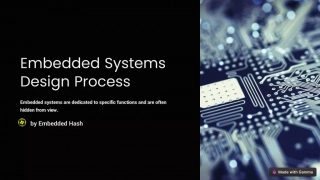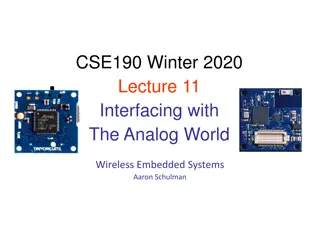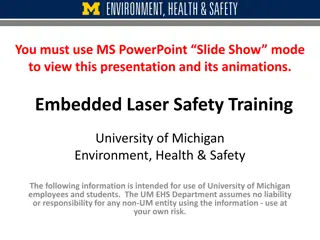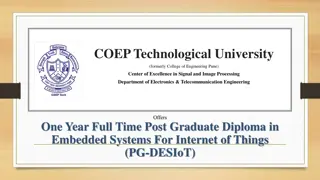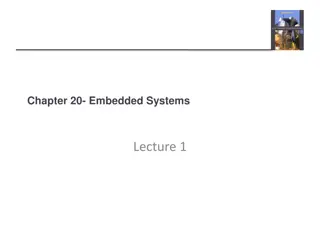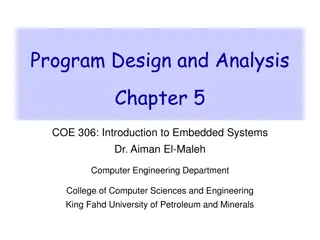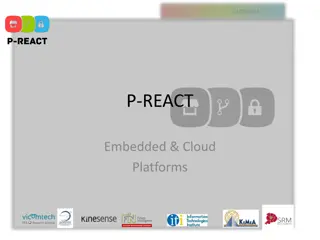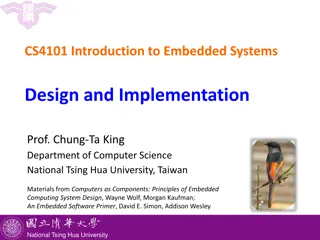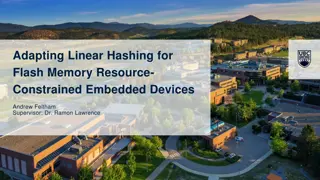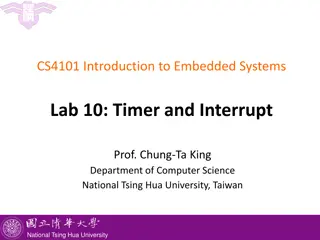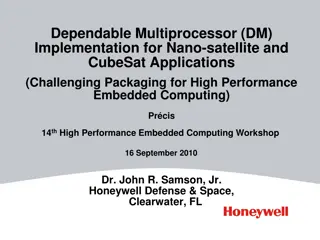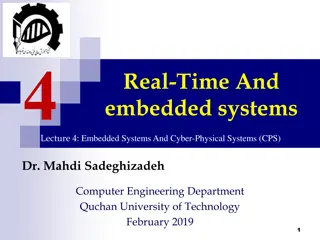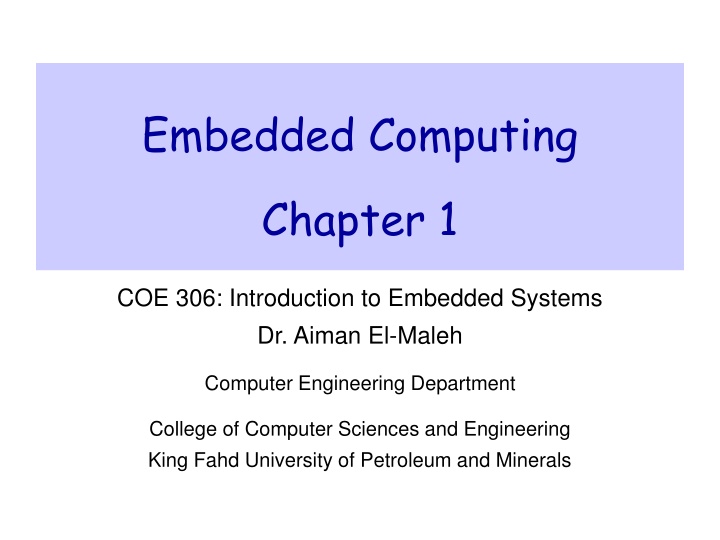
Introduction to Embedded Computing Systems and Applications
Discover the world of embedded computing systems with this insightful guide. Learn about the challenges in design, the importance of formal system description, and explore application examples ranging from simple controls in household appliances to complex systems in automobiles. Dive into the realm of embedded systems with real-world examples like the BMW 850i Antilock Brake System and understand the concept of Cyber-Physical Systems.
Download Presentation

Please find below an Image/Link to download the presentation.
The content on the website is provided AS IS for your information and personal use only. It may not be sold, licensed, or shared on other websites without obtaining consent from the author. If you encounter any issues during the download, it is possible that the publisher has removed the file from their server.
You are allowed to download the files provided on this website for personal or commercial use, subject to the condition that they are used lawfully. All files are the property of their respective owners.
The content on the website is provided AS IS for your information and personal use only. It may not be sold, licensed, or shared on other websites without obtaining consent from the author.
E N D
Presentation Transcript
Embedded Computing Chapter 1 COE 306: Introduction to Embedded Systems Dr. Aiman El-Maleh Computer Engineering Department College of Computer Sciences and Engineering King Fahd University of Petroleum and Minerals
Next . . . What are Embedded Computing Systems? Challenges in Embedded Computing System Design Design Methodology Formal System Description: UML Embedded Computing COE 306 Introduction to Embedded System KFUPM slide 2
What is an Embedded System? Embedded computing system: any device that includes a programmable computer but is not itself a general-purpose computer. Take advantage of application characteristics to optimize the design: don t need all the general-purpose bells and whistles. Examples: calculator, fax, clock, coffee maker, cell phone, printer, TV, microwave, camera, car (40 100 microcontrollers) It all started from a calculator: using Intel 4004 microprocessor Embedded Computing COE 306 Introduction to Embedded System KFUPM slide 3
Embedding a Computer Microcontroller: includes CPU, I/O devices, on-board memory. Embedded Computing COE 306 Introduction to Embedded System KFUPM slide 4
Application Examples Simple control: front panel of microwave oven, etc. Canon EOS 3 has three microprocessors. 32-bit RISC CPU runs autofocus and eye control systems. Digital TV: programmable CPUs + hardwired logic. Today s high-end automobile may have 100 microprocessors: 4-bit microcontroller checks seat belt; microcontrollers run dashboard devices; 16/32-bit microprocessor controls engine :determining when spark plugs fire, controlling the fuel/air mixture, etc. Low-end cars use 20+ microprocessors. Embedded Computing COE 306 Introduction to Embedded System KFUPM slide 5
Examples of Embedded Systems Embedded Computing COE 306 Introduction to Embedded System KFUPM slide 6
BMW 850i Antilock Brake System An antilock brake system (ABS) reduces skidding by pumping the brakes. The purpose of an ABS is to temporarily release the brake on a wheel when it rotates too slowly. Embedded Computing COE 306 Introduction to Embedded System KFUPM slide 7
Cyber-Physical Systems A physical system that tightly interacts with a computer system. The embedded computer is the cyber-part of the cyber- physical system. Computers replace mechanical controllers: More accurate. More sophisticated control. Engine controllers replace distributor, carburetor, etc. Complex algorithms allow both greater fuel efficiency and lower emissions. Embedded Computing COE 306 Introduction to Embedded System KFUPM slide 8
Characteristics of Embedded Systems Sophisticated functionality Often have to run sophisticated algorithms or multiple algorithms: e.g., a microprocessor controlling automobile engine Often provide sophisticated user interfaces: e.g. moving maps in Global Positioning System (GPS) Real-time operation Must finish operations by deadlines. Hard real time: missing deadline causes failure; e.g., missed deadlines in printers can result in scrambled pages Soft real time: missing deadline results in degraded performance; e.g., Streaming audio-video Many systems are multi-rate: must handle operations at widely varying rates; audio and video of a multimedia stream run at very different rates, but they must remain closely synchronized. Embedded Computing COE 306 Introduction to Embedded System KFUPM slide 9
Characteristics of Embedded Systems Low manufacturing cost Many embedded systems are mass-market items that must have low manufacturing costs. Cost is determined by type of microprocessor, amount of memory, type of I/O devices. Low power Power consumption is critical in battery-powered devices. Excessive power consumption increases system cost even in wall-powered devices. Designed to tight deadlines by small teams Often designed by a small team of designers. Often must meet tight deadlines: 6 month market window is common; Can t miss back-to-school window for calculator. Embedded Computing COE 306 Introduction to Embedded System KFUPM slide 10
Implementation Alternatives Microprocessor, custom hardware (ASICs), FPGAs Embedded Computing COE 306 Introduction to Embedded System KFUPM slide 11
Why Use Microprocessors? Efficient 1+ IPC for modern RISC processors Large design teams / mass production Highly optimized (speed, power) Latest manufacturing technology (fabrication) Single-design for multiple functions / general-purpose Implementing several functions on a single processor often makes much better use of the available hardware budget Flexible Separate hardware/software design by different teams Easier to design cost-effective families/generations of products Embedded Computing COE 306 Introduction to Embedded System KFUPM slide 12
Embedded Computing Platform Embedded computing platform: hardware architecture + associated software. Why not use PCs for all embedded computing? real-time performance requirements often drive us to different architectures low power and low cost also drive us away from PC architectures and toward multiprocessors Custom embedded systems that are designed for an application, such as a cell phone burn several orders of magnitude less power than do PCs with equivalent computational performance, they are considerably less expensive as well. Embedded Computing COE 306 Introduction to Embedded System KFUPM slide 13
Challenges in Embedded System Design How much hardware do we need? type of microprocessor, amount of memory, peripheral devices performance-cost tradeoff How do we meet deadlines? Faster hardware or cleverer software? Faster hardware increases cost and power consumption How do we minimize power? Turn off unnecessary logic? Reduce memory accesses? Careful design is required to slow down noncritical parts of the machine while still meeting necessary performance goals Excessive power consumption reduces battery life and increases heat dissipation Embedded Computing COE 306 Introduction to Embedded System KFUPM slide 14
Challenges in Embedded System Design How do we design for upgradeability? Support multiple versions/generations using the same hardware How can we design a machine that will provide the required performance for software that we haven t yet written? Does it really work? Is the specification correct? Does the implementation meet the spec? How do we test for real-time characteristics? How do we test on real data? How do we work on the system? Limited observability and controllability; no keyboard and screen Restricted development environments Embedded Computing COE 306 Introduction to Embedded System KFUPM slide 15
Performance of Embedded Computing Systems In general-purpose computing, performance often means average-case, may not be well-defined. In real-time systems, performance means meeting deadlines: Missing the deadline by even a little is bad. We need to analyze the system at several levels of abstraction to understand performance: CPU: pipelined CPU with a cache Platform: bus and I/O devices Program: structure and overall behavior Task: multitasking system with tasks interaction Multiprocessor: interaction between processors Embedded Computing COE 306 Introduction to Embedded System KFUPM slide 16
The Computing Stack EE 202, EE 203 Embedded Computing COE 306 Introduction to Embedded System KFUPM slide 17
Importance of Design Methodology Design methodology is a procedure for designing a system. Helps in tracking design objectives and keeps a scorecard on design to ensure nothing is skipped. Compilers, software engineering tools, computer-aided design (CAD) tools, etc., can be used to: help automate methodology steps; keep track of the methodology itself. Team communication and coordination a design methodology makes it much easier for members of a design team to communicate. Embedded Computing COE 306 Introduction to Embedded System KFUPM slide 18
Design Goals Functionality and user interface Performance Overall speed, deadlines Manufacturing cost Power consumption Other requirements (physical size, weight, etc.) Embedded Computing COE 306 Introduction to Embedded System KFUPM slide 19
Embedded System Design Process Top-down design: Requirements start from most abstract description; work to most detailed. Bottom-up design: Specification work from small components to big system. Architecture Real design uses both techniques. At each level of abstraction, we must: Component Design analyze the design to determine how to meet specifications; System Integration refine the design to add detail. Embedded Computing COE 306 Introduction to Embedded System KFUPM slide 20
Requirements Plain language description of what the user wants and expects to get. Functional requirements output as a function of input. Non-functional requirements Performance: time required to compute output; Cost: includes manufacturing and nonrecurring engineering (NRE) costs Physical size and weight power consumption, reliability; etc. Validating requirements: mock-ups, physical non- functional models. Embedded Computing COE 306 Introduction to Embedded System KFUPM slide 21
Requirements Analysis Requirements analysis Check for requirements consistency; Requirements form (summary) name purpose inputs outputs functions performance manufacturing cost power physical size/weight Types of data: Analog? Digital? Data Characteristics: Periodically arriving data? Occasional user inputs? #bits per data element? Types of I/O devices: Buttons? Analog/Digital Conv.? Video displays? Embedded Computing COE 306 Introduction to Embedded System KFUPM slide 22
Example: GPS Moving Map Requirements Moving map obtains position from GPS, paints map from local database. Functionality: For automotive use. Show major roads and landmarks. User interface: At least 400 x 600 pixel screen. Three buttons max. Pop-up menu. Performance: Map should scroll smoothly. No more than 1 sec power-up. Lock onto GPS within 15 seconds. Cost: $120 street price = approx. $40 cost of goods sold. Physical size/weight: Should fit in hand. Power consumption: Should run for 8 hours on four AA batteries. Embedded Computing COE 306 Introduction to Embedded System KFUPM slide 23
GPS Moving Map Requirements Form name GPS moving map purpose consumer-grade moving map for driving inputs power button, two control buttons outputs back-lit LCD 400 X 600 functions 5-receiver GPS; three resolutions; displays current lat/lon updates screen within 0.25 sec of movement $40 cost-of-goods-sold performance manufacturing cost power 100 mW physical size/weight no more than 2" X 6", 12 oz. Embedded Computing COE 306 Introduction to Embedded System KFUPM slide 24
Specification A formal more precise description of the system that reflects the customer s requirements in a way that can be clearly followed during design. should not imply a particular architecture; provides input to the architecture design process. A contract between the customer and the architects Clarifies design objectives and prevents faulty assumptions Should be: Understandable: so it can be verified against requirements Unambiguous: so designers are clear about what to build Embedded Computing COE 306 Introduction to Embedded System KFUPM slide 25
GPS Specification Should include: data received from the GPS satellite constellation; map data; user interface; operations required to satisfy user requests; background operations needed to keep the system running. Unified Modeling Language (UML) is a language used for describing specifications. Embedded Computing COE 306 Introduction to Embedded System KFUPM slide 26
Architecture Design Purpose of architecture is to describe how the system implements required functions Plan for overall structure of the system What major components are needed for satisfying the specification? Hardware components: CPUs, peripherals, etc. Software components: major programs and their operations. Block diagrams: General architecture, Hardware architecture, Software architecture Must satisfy functional and non-functional requirements Embedded Computing COE 306 Introduction to Embedded System KFUPM slide 27
GPS Moving Map Block Diagram Shows major operations and data flows among them GPS receiver search engine display renderer user interface database General Architecture Embedded Computing COE 306 Introduction to Embedded System KFUPM slide 28
GPS Moving Map Hardware Architecture CPU display frame buffer GPS receiver memory panel I/O Embedded Computing COE 306 Introduction to Embedded System KFUPM slide 29
GPS Moving Map Software Architecture Timer used to control when we read the buttons on the user interface and render data onto the screen pixels position database search renderer user interface timer Embedded Computing COE 306 Introduction to Embedded System KFUPM slide 30
Designing Hardware and Software Components Building system components in conformance to the architecture and specification. Some components are ready-made, some are modified from existing designs, others designed from scratch. Ready-made, standard components CPU, memory, GPS receiver Software library, topographic data databases Custom components PCB, FPGA Custom software modules Embedded Computing COE 306 Introduction to Embedded System KFUPM slide 31
System Integration Putting the system components together Many bugs appear only at this stage Have a plan for integrating components to uncover bugs quickly, test as much functionality as early as possible Bug discovery Building the system in phases Testing Inserting appropriate debugging facilities during design can help ease system integration problems. Debugging facilities for embedded systems are usually much more limited than what you would find on desktop systems; always a challenge. Embedded Computing COE 306 Introduction to Embedded System KFUPM slide 32
Formal System Description Unified Modeling Language (UML): A visual, object- oriented modeling language used to capture design tasks Designed to be useful at many levels of abstraction in the design process described as a number of interacting objects some of those objects correspond to real pieces of software or hardware in system; others correspond to people or machines Structural Description: the system components Behavioral Description: how the system components act Embedded Computing COE 306 Introduction to Embedded System KFUPM slide 33
Structural Description Classes, interfaces, and objects A class is a form of type definition. It defines attributes that an object may have and operations that determine how the object interacts with the rest of the world. Embedded Computing COE 306 Introduction to Embedded System KFUPM slide 34
The Class Interface The operations provide the abstract interface between the class s implementation and other classes. Operations may have arguments, return values. An operation can examine and/or modify object s state. Choose your interface properly If the interface is too small/specialized: object is hard to use and reuse. If the interface is too large: class becomes too cumbersome for designers to understand; implementation may be too slow; spec and implementation are probably buggy. Embedded Computing COE 306 Introduction to Embedded System KFUPM slide 35
Structural Description A conceptual model, not tied to implementation Relationships between classes: Association: classes communicate but one does not own other. One class uses the functionalities provided by another class. Aggregation: a complex class is made of several smaller classes. The child can exist independently of the parent. Composition: aggregation in which owner does not allow access to its components. The child cannot exist independent of the parent. Generalization: define one class in terms of another. A superclass has the most general attributes, operations, and relationships that may be shared with subclasses. A subclass may have more specialized attributes and operations. Embedded Computing COE 306 Introduction to Embedded System KFUPM slide 36
Relations Examples Association Composition Aggregation Embedded Computing COE 306 Introduction to Embedded System KFUPM slide 37
Class Derivation: UML Generalization May want to define one class in terms of another. Derived class inherits attributes, operations of base class Embedded Computing COE 306 Introduction to Embedded System KFUPM slide 38
Multiple Inheritance Embedded Computing COE 306 Introduction to Embedded System KFUPM slide 39
Links and Associations Link: describes relationships between objects. Association: describes relationship between classes. Links between objects Association between classes Embedded Computing COE 306 Introduction to Embedded System KFUPM slide 40
Behavioral Description: State Machine Event-driven: An event is some type of action. It may originate outside the system or inside it. Types of events A signal is an asynchronous occurrence. It is defined in UML by an object that is labeled as a signal . A call event follows the model of a procedure call in a programming language. A time-out event causes machine to leave state after certain amount of time. Embedded Computing COE 306 Introduction to Embedded System KFUPM slide 41
Behavioral Description: State Machine Embedded Computing COE 306 Introduction to Embedded System KFUPM slide 42
Behavioral Description: Sequence Diagram Shows sequence of operations over time Describes how and in what order a group of objects work together Shows a particular scenario Embedded Computing COE 306 Introduction to Embedded System KFUPM slide 43
Summary Embedded computers are all around us Many systems have complex embedded hardware and software. Embedded systems pose many design challenges: design time, deadlines, power, etc. Design methodologies help us manage the design process. Object-oriented design helps us organize a design. UML is a transportable system design language Provides structural and behavioral description primitives. Embedded Computing COE 306 Introduction to Embedded System KFUPM slide 44

